Akihabara: Otaku nesting site
In Tokyo, there is its own “Pink Top”, only it is called the “Valley of Autumn Leaves”. Kanda district, Akihabara station, and so - Akiba. The name of the area received from a special fire-fighting temple, which is now considered the sanctuary of the anime. And now I am quite seriously.

Temple anime. On normal tablets, wishes are written like “health to relatives”. There are other desires. Totally different.
The subdistrict itself from the river to the 6th quarter is also called “Electro-town”, because they used to trade in electronics there. “Radio tower” or the high-rise Radio Kaikan of the 62nd year of construction is the germ of the electric city, from where it all went, the first tallest building in the area. Well, then it was high, and now just one of many, and not so great. There were shops, and at the bottom of the collapse of used electronics. In 2011, however, the high-rise broke up an earthquake (it was recognized as an emergency), but it was quickly rebuilt by 2014. And now inside the shopping center of the ring type, where every heap of goods for otaku. In general, you can just wander around it and the next building, and it will turn out to be a mini-Akiba.
')
In general, I walked around the area myself, and then I found local fixers, who showed it from two different sides and led to a couple of secret levels. I must say, walking around Akiba without a local or a detailed guidebook is an idea so-so.

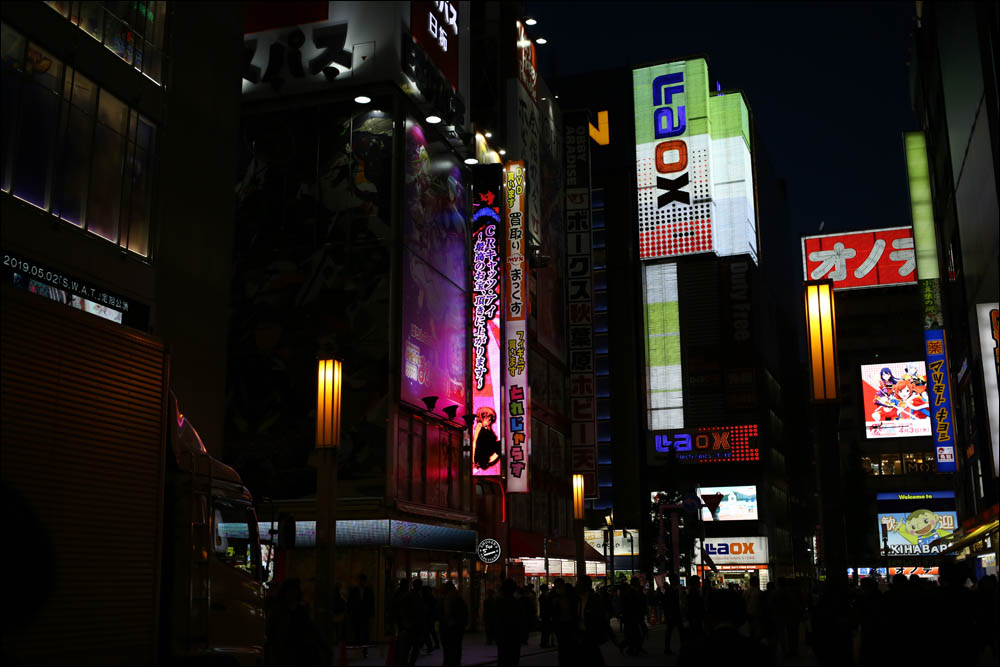
The observations are further based on personal experience and stories of fixers. The first maid is a professional cosplayer (in the sense that she is paid for participating in events in a costume), she works in anime dubbing, she has “30 working votes” and two phones, one for life, the second for work. The second is otaku, who earns money on trips to find a particular rare commodity in Akiba, an awesome specialist in anime and manga. I draw your attention to the fact that, like almost all Japanese people, both of my respondents are very focused on their areas to an incredible level, and at the same time they are hardly interested in others. That is, the story may contain inaccuracies and a rather one-sided point of view (this is why I needed two fixers). Even on the territory of 6 blocks, they have their favorite places, so two campaigns overlapped only by 10 percent.
This is the region of the Electro-town northwest of Akihabara station. The station itself is on a circular branch, that is, in the main transfer loop, therefore it generates very good traffic. On the one hand from Akiba there is a traditional shopping mall with souvenirs for not very picky tourists, on the other, the Kanda book district, and if you move further from the station, there will be lonely shops on Akiba, but their density will start to fall sharply until the area will not turn into a residential area.

Bookstores in Kanda (Cando)
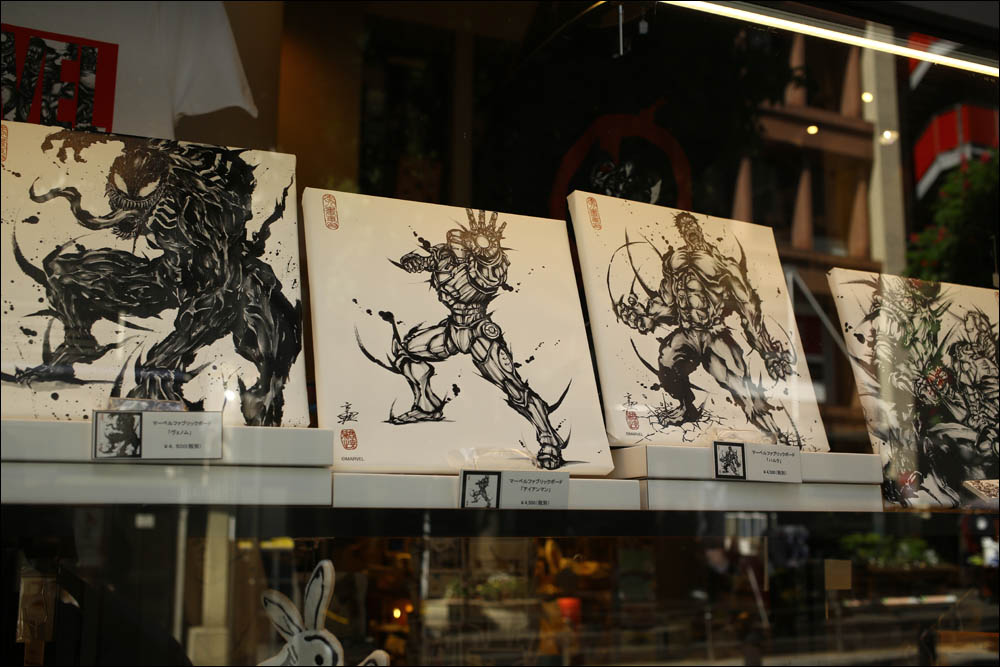
Somewhere in the area begins the Japanese pan of American characters
In the morning, Akiba represents sluggishly awakening vendors and opening stores. At lunchtime, this is a resting place for heaps of Japanese people who want to eat or run for something in place, everything works, but life is inside buildings. By evening, a huge crowd appears on the streets, including cosplayers, girls barkers come out of a maid cafe with leaflets and everything starts to glow with neon. Since the collapse of the lost part of the interesting, because it has already been bought. That is the best option - to come around 15 days and wander until dark.
On the territory is a temple, which was built after a fire in the area to maintain fire protection. He gave the name Akihabare. Do not ask me what the temple and the fire department have in common, because the other is more interesting. In ordinary temples, people write their wishes on special wooden tablets and hang them on strings for such things:
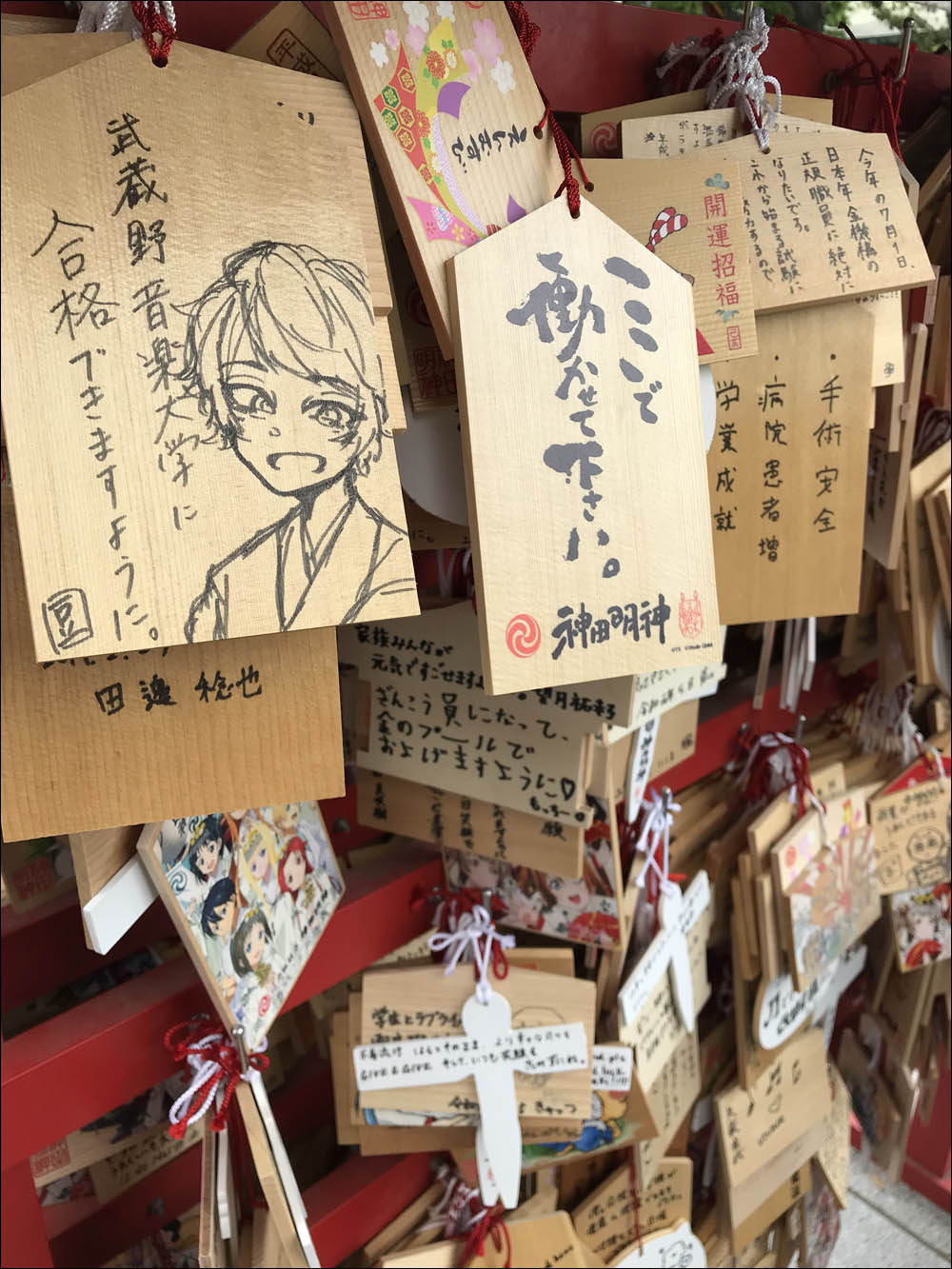
Everyone can read them, and this is part of the ritual. So, somehow it turned out that since the start of trade here with manga and videotapes people somehow suddenly began to write desires in the spirit: “I want the continuation of this manga”, “I wish the third season would come out” and so on. As a result, today the wishboard is almost completely about anime.
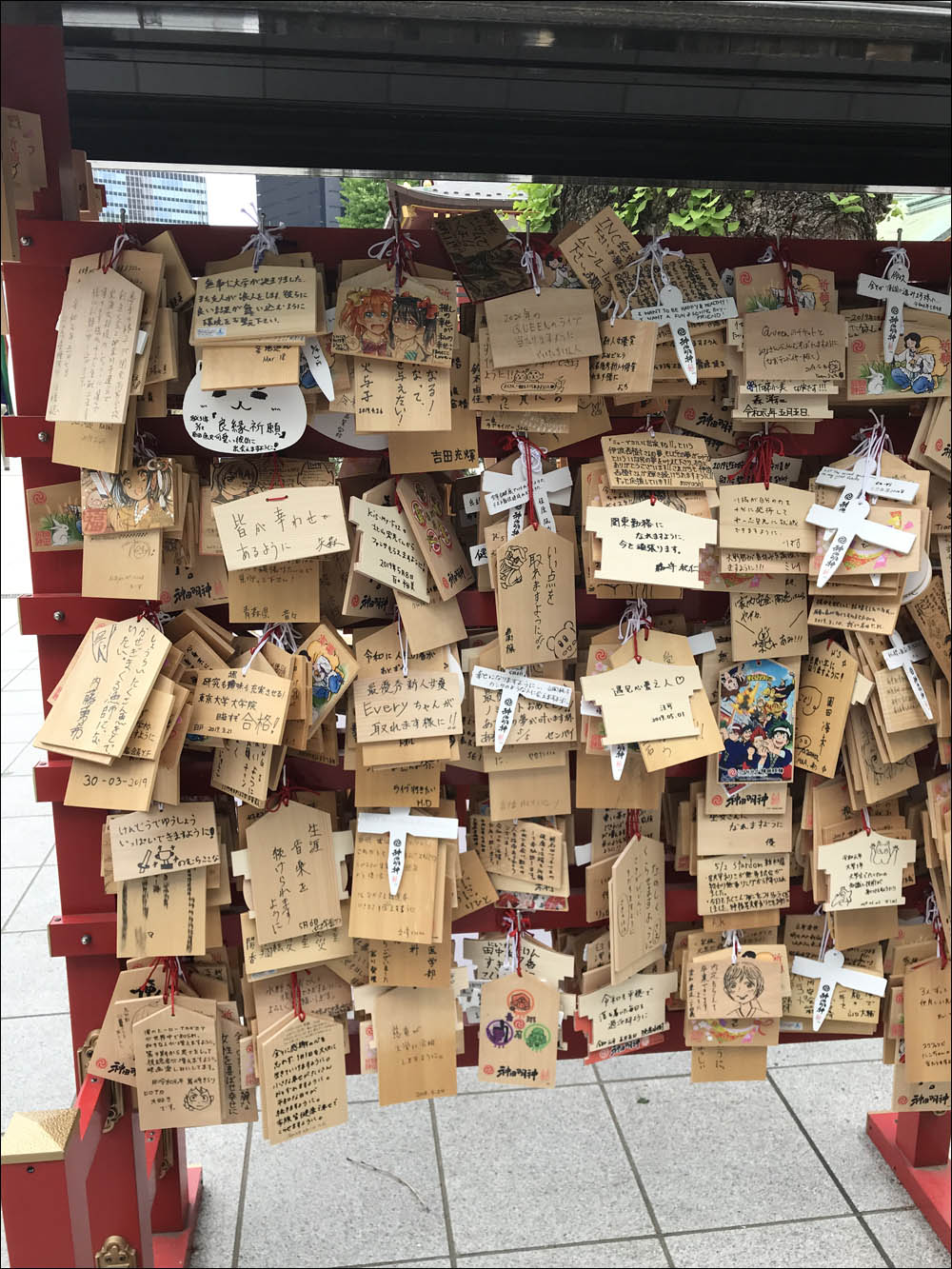
Further, the classical loop of positive feedback: seeing this, the temple began to produce boards with an anime theme (these color drawings are a pattern of wish boards, and the black and white sides are UGC). That did not leave a chance to make "normal" desires.
And finally - next to the stairs, where everyone takes pictures, because the places near this temple appear in the anime. And it is very provoking Otaku.
The second feature of the area is a lot of machine guns, game players, handlers of random things and scam. These are 4 different categories of entertainment.
Automata are a variety of slot machines, united in a cluster like slot casinos under the local name “pachinko” (in Russian transliteration - pachinko). There go to try to win money classic maniacs of gambling. Sitting in pachinko is considered something of an alcoholism, but popularity does not fall - inside there is a very competent atmosphere of celebration and joy. I guess when you are a very polite and hard-restraining person, this can be an unexpectedly important emotional valve. In general, something like a special tax on those who do not know mathematics.
Igrovuhi is things where you can play different games. There are machines for online games, there are for singles, you can connect adjacent machines in a local network and play fighting games together if you want. Usually they are divided into groups - the floor of rhythm games such as drum sets and dances, the floor of fighting games, the floor of shooters, and so on. The general principle (not always the case, but conveys the idea) - you throw a coin of 100 yen (about 50 rubles) into a machine, and the better you play, the less often you have to throw a new one. In a fighting game for two victories, the loser needs a new coin, and the winner can continue like this. The longest time for one coin is to have fun in rhythm machines (such as dance halls or guitar-hiro), so they are popular. The wildest hardcore complexity, unimaginable for Europeans, turns out to be quite affordable for local teenagers. When you watch a person playing at super speed, you begin to believe in fixed behavior with DMA and assembler inserts.


Throwing out random things is a type of vending machine in which you put a coin, and you get a ball with something inside. We have so boot covers for 5-10 rubles, sometimes in hospitals. So, the feature of capsule machines is that the result is guaranteed for you, but you don’t know what exactly inside the capsule is before the opening. Each machine has its own theme: pokemons, characters of a particular anime, robots, and so on. Items are collectible and differ in different frequency of hit. If you need Pikachu, you can squander half the salary, trying to extricate the desired capsule, because Sloupoka will come across.
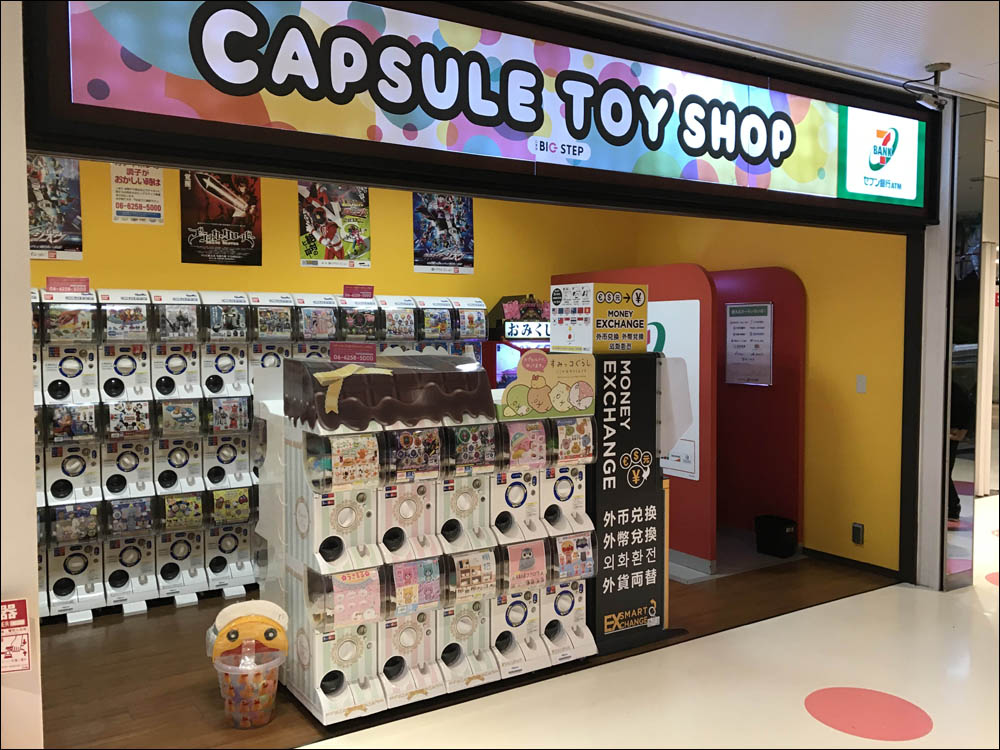
This is a cluster in another area of the city. In Akiba, the machine guns are shoved quite chaotically.
And, finally, "scam". Specifically, here it is usually some kind of electronics, soft toys or, more often, figures of anime characters piled inside the machine, where an iron hand fumbles. A scam creates the illusion that pulling out a toy is easier than it seems, but every time you lack a little bit of angle or precision. But, nevertheless, you can get a figure.

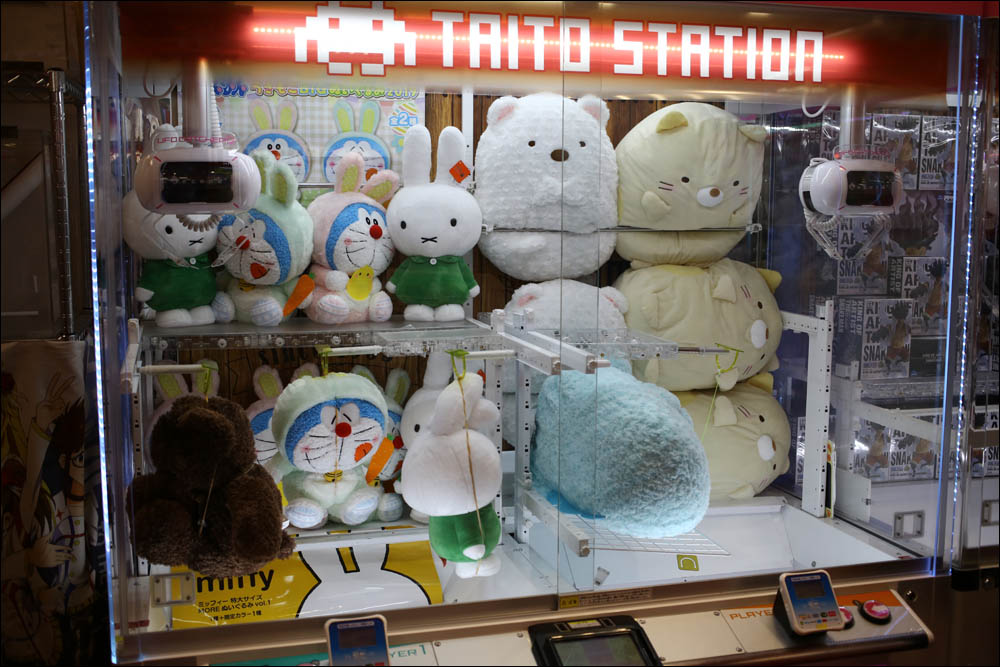
I also met a professional deliverer: he looked out for situations when he was almost certain that he would get something, played, won an item, put it in a huge shuttle bag (already two-thirds full, mostly soft toys) and went to look out for floor next suitable situation. They say there are similar specialists who, for a reduced number of attempts, can win you the necessary thing from an automaton, but these are two completely different skills.
Actually, the most interesting thing happens next to the won figures.

Shops here are of several types: those that bring their goods and sell them as usual with us; “Collapses”, where everything happens like in a classic flea market, only other objects act as goods; and stores that both sell and buy things. That is, they work like a collapse, but still have their new product.
Now pricing on the figures. It very much depends on the rarity and desirability of the figure. That is, with a slight delay is determined by demand. On the other hand, several different manufacturers can take a license for the figure, and make different versions of the same character. In general, all this is governed by fashion (or rather, what is happening now) and the collection value of the figure.

The sign at the beginning is not a seven, but a yen. In rubles will be about half the price of the yen on the price tag.
Why this is important - because the Japanese have not so much space at home, and if he also lives in a rented apartment, he will be able to put one, a maximum of two figures in front of him. Yes, and so the usual otaku rarely gains more than 10 figures, and non-otaku generally buys them exclusively spontaneously, that is, almost never. This means that there is a lot of competition for the slot. This means that the figure you will choose the best possible.
We return to the machines. Figures that are in the machines, called "arcade", and they are more common in the secondary market. Because those who wanted to get another figurine donate the wrong things from the capsules or the lohotron hooks to stores for resale. As a result, if you really need a specific figurine from a machine, it is often much more rational to buy it in a shop nearby.
Rare figures can only be bought, so the prices are higher than the arcade ones.
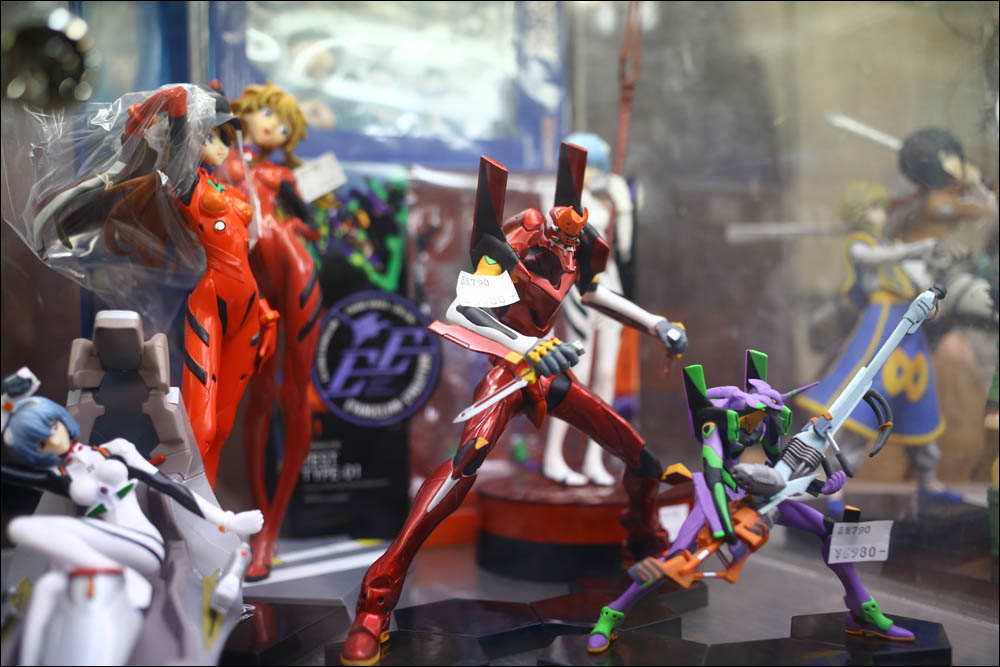
Why otaku take figures? Firstly, because it is an identity. As we have a bookcase, they have - a figure above the table with a computer. Secondly, the object of art. Thirdly, as a poster - just like to look at the figure. Many figures are made deliberately erotic, there is a whole market of pure uh ... nude figures. Another maiden-fixer bought figures to draw heroes from them, and then sold them back to the shops. The same logic.
Characters are divided into two types: cute (kavai) and cool. Steep are those who you would like to be. Lovely - those who are nice to look at. Criteria for steepness and grace predictably broke down on Sephiroth (yes, I remember this bike), because when I asked to list the criteria, everything coincided except for the predominantly black color of the hero. Lovely have a large share of pink. More cute ones usually have more childish features (proportion of eyes to nose). Fixer once again looked at Sephiroth with suspicion and said that yes, the cultural difference is great. It seems to me that he is no longer cool.

And this is American

Well, nastolki predictable here. Shops are still the old generation on the principle of "so did our ancestors." Almost nothing new except the fact that now on some games there are “sample” stickers, it means you can open and watch. Sellers have little knowledge of the base of games, the cascade layout, on the side of the game. Everything is sharpened by the fact that a person knows in advance what kind of game he needs. Prices as we have on a lot, but the same Sickle is cheaper.
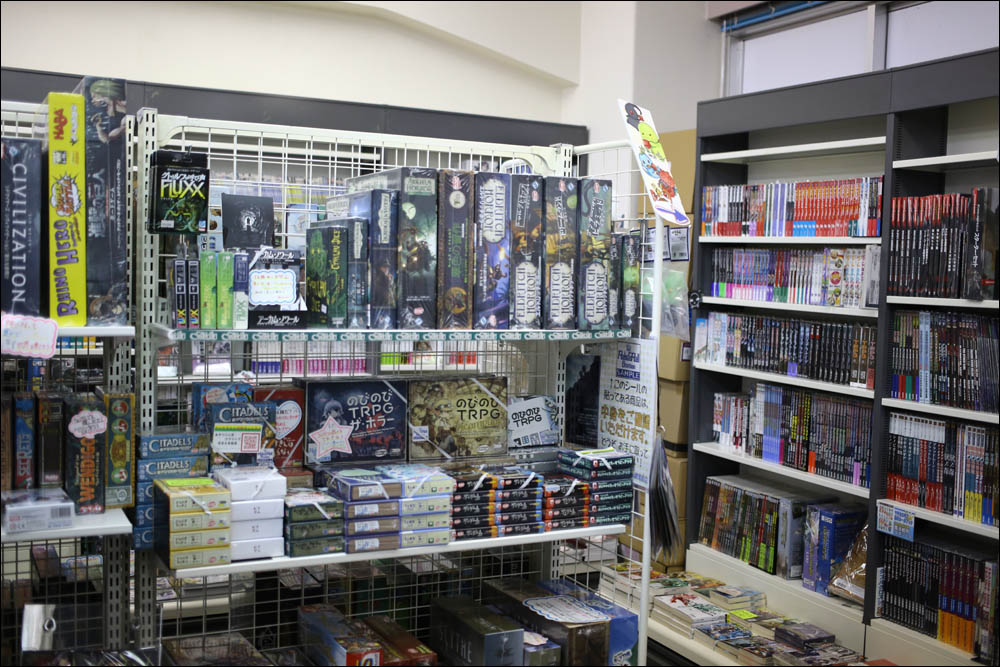
A very large section of collectible card games. They are even in bookstores outside the district, there are many of them, and they are all with the coolest art, and it is clearly visible to different audiences. Many KKI can be produced in cobranding with anime brands (characters from different TV shows).

Shelf with open games like our playing pool, but playing right in the store behind the curtain. Game rooms are even in large bookstores.
From the pleasant - our friends' lineup from the exhibition in Essen is in place, and the domestic headheads too.
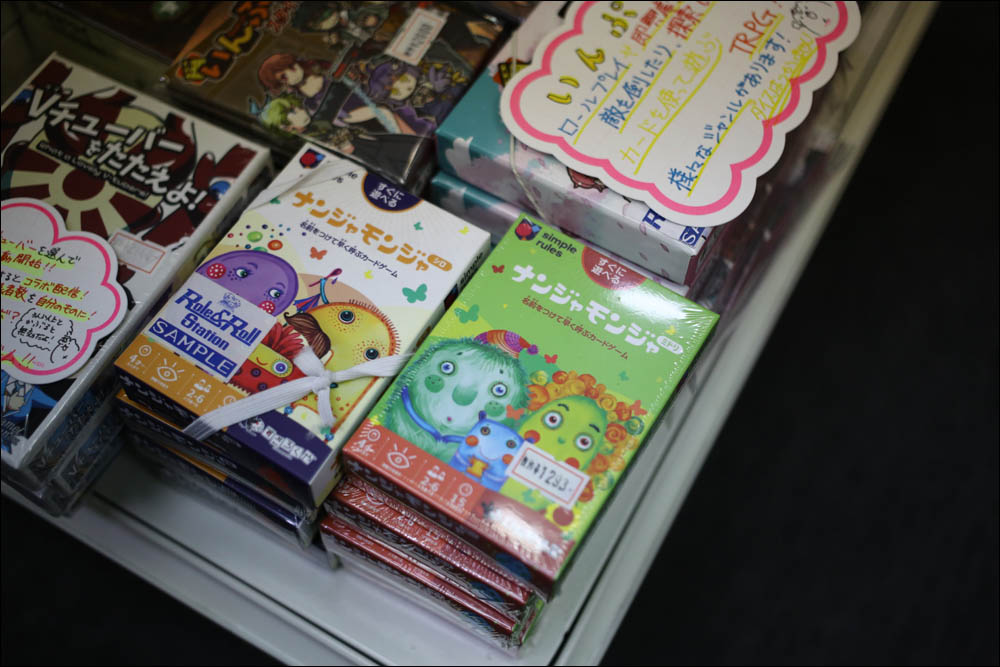
KKI Magic: the Gathering started advertising with the metro.
Here is the street:

You can go and watch:

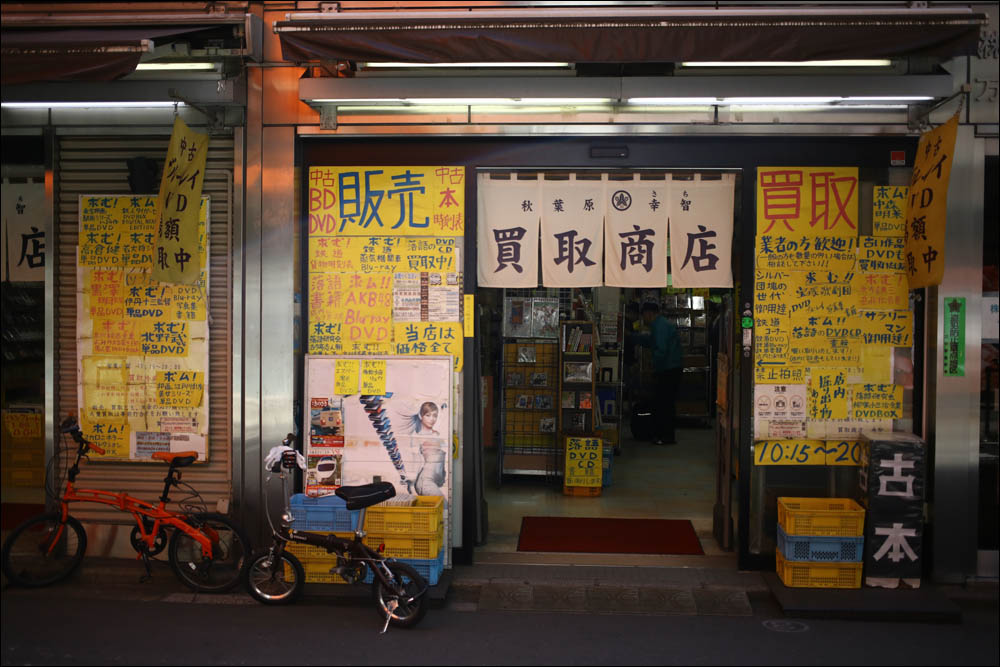
TVs and consoles (TV is harder to find, as I understand it):
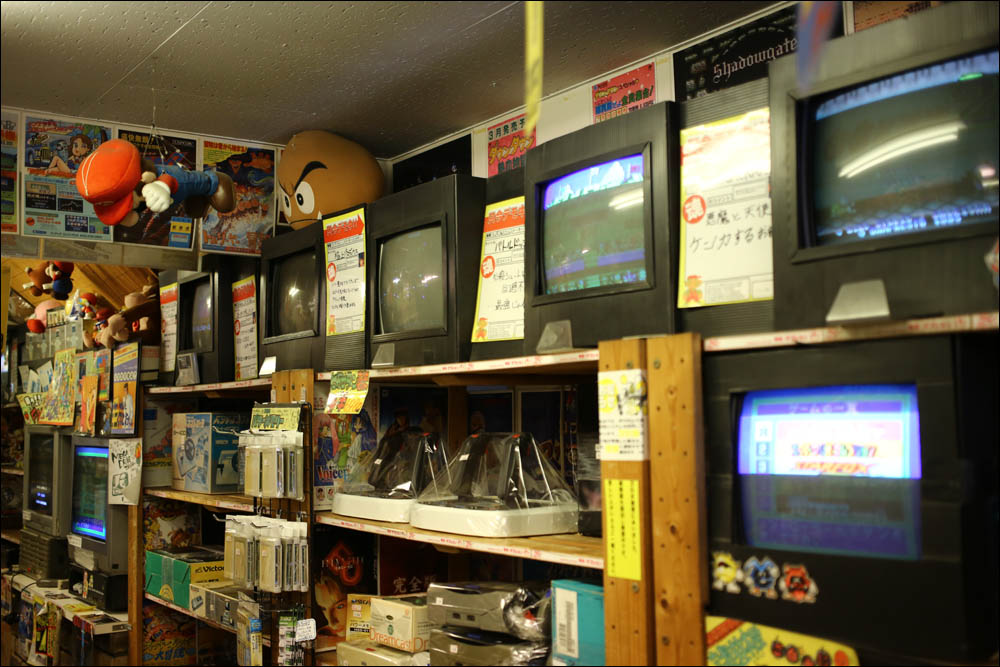
There is no wolf:

Consoles:

Stuffed Toys:


All for cosplay:


The book in which both parts of the manga “All you need is kill” were found (the source line for the film “Edge of the Future” in Russian is a book, and it is even pretty well translated).


And here is something important, what is forbidden to search for. It looks like boosters with something voluminous. It reminds me of a story about one large network that purchased figures of movie characters, the coolest ones sold, and the rest were returned to the supplier under the contract.

In the streets past these shops go different inspired people. Someone came to dinner and at the same time to see something in the book of manga. Someone came in a costume character to walk. Young people make noise in a cafe. Otaku carefully steal between the shelves and look out for figures for the secondary market. Someone brought to sell their figures (they can be put in stores here). Here are young American servicemen trying to pick up hentai manga. Someone is unpacking a new delivery. In general, the radio market. But with specificity.
On holidays, cosplayers come and arrange a show. But on ordinary days, people are 95% civilian Japanese, 3% civilian tourists, and only 2% strange people.
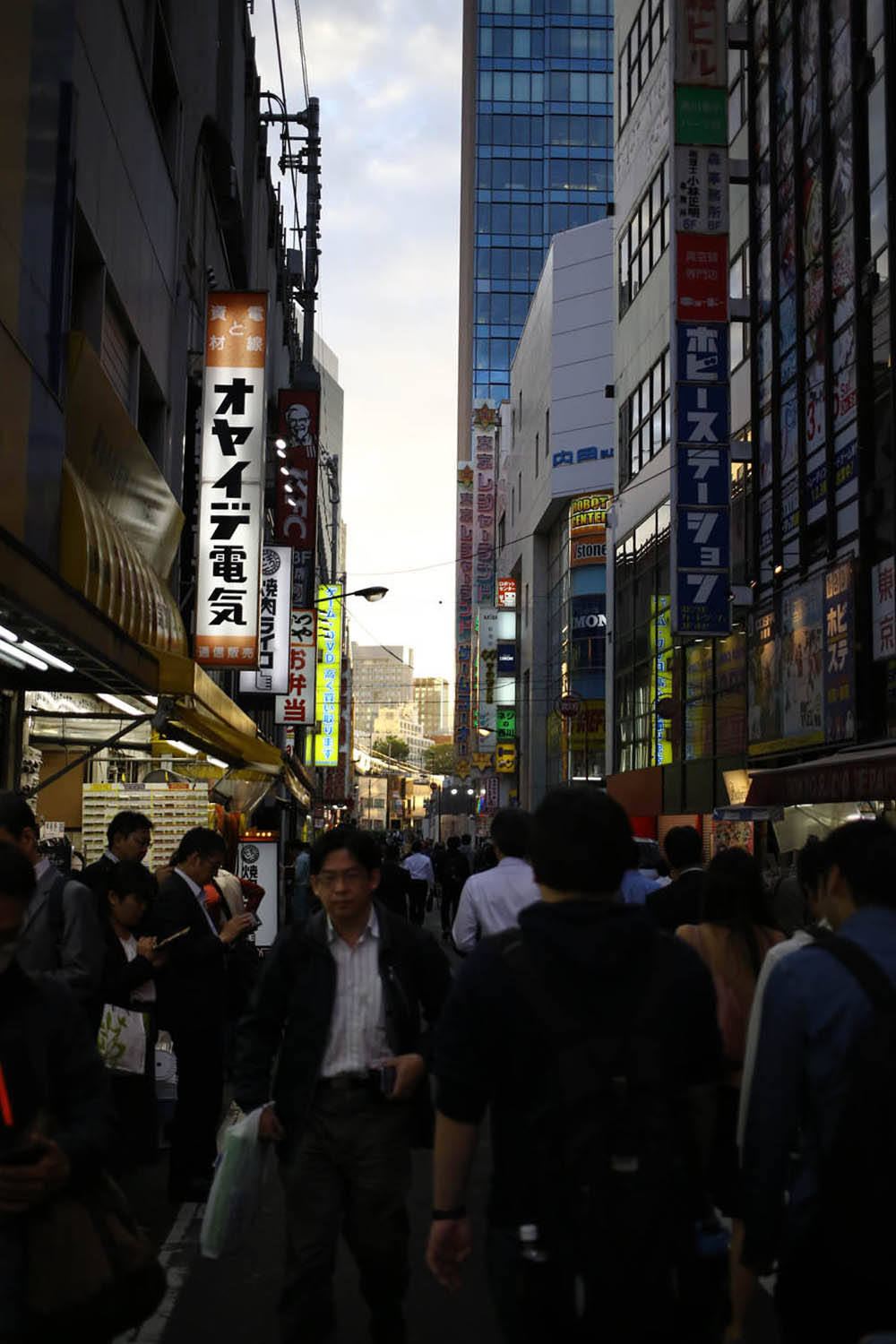
In Japan, there is a maid-cafe. These are places where waitresses and hostesses work beautiful girls (for Japanese taste), who all those 20 minutes that you drink coffee are madly in love with you. And they are called so, because the first uniforms were “for maids”, but then a cafe appeared with waitresses in tight ninja suits, military and other items of the wardrobe department of 18+ stores.

The love of girls is expressed in five times the price of coffee and food and how they smile at you, talk to you and support you in every way. Judging by the weary businessmen inside, for many it is a great opportunity to communicate with a lively girl so that she does not get away with the brain. In addition to talking about the weather, there are various services in a cafe: somewhere you can gently brush your ears with cotton buds, sing a touching song or dance. In different cafes different chips. In the cafe where the fixer brought me, the service is standard: you can order any drawing for coffee. Your waitress comes with a bottle of pink-red syrup and draws on the skin what you tell her. Slowly and kayfno, something cute chirping in Japanese at the same time and inserting "nya" every five to six words. Typically ordered drawing of a cat, a portrait of the anime heroine, a heart with your name, a flower and so on.
I had a model of hallucinia with me - prehistoric creature with tentacles. Reliable, and I took it in the morning from the store of the biological museum. It looks unusual even for the Cambrian period. Two rows of legs: six tentacles on the left in two layers and eight on the right. More precisely, this is top and bottom in fact, and the bottom she walks, and on horseback she defends herself against enemies. But it is not important. The important thing is that I was carrying this monster as a gift, and it was in my pocket. When the girl with the syrup asked what exactly to draw, I could not resist and put a hallucinuyu on the table.
The lady from my Cambrian nuthatch has bridged the firmware. This crap is clearly scary. But at the same time it is pink. And as a Japanese, you should understand that pink crap is not terrible. She looked once more into the bulging eyes of the cockroach. Then she dared to gently touch his foot. Paw was soft, it gave her confidence. The neural network suggested a solution: pink, with big eyes and soft paws - these are supporting signs.
“Kawai? ..” the beautiful maiden said uncertainly.
Once again I touched the other foot and was delighted:
- Kawai!
And drew.

And so that there was no doubt what a nice hallucination was, she added hearts.

Temple anime. On normal tablets, wishes are written like “health to relatives”. There are other desires. Totally different.
The subdistrict itself from the river to the 6th quarter is also called “Electro-town”, because they used to trade in electronics there. “Radio tower” or the high-rise Radio Kaikan of the 62nd year of construction is the germ of the electric city, from where it all went, the first tallest building in the area. Well, then it was high, and now just one of many, and not so great. There were shops, and at the bottom of the collapse of used electronics. In 2011, however, the high-rise broke up an earthquake (it was recognized as an emergency), but it was quickly rebuilt by 2014. And now inside the shopping center of the ring type, where every heap of goods for otaku. In general, you can just wander around it and the next building, and it will turn out to be a mini-Akiba.
')
In general, I walked around the area myself, and then I found local fixers, who showed it from two different sides and led to a couple of secret levels. I must say, walking around Akiba without a local or a detailed guidebook is an idea so-so.


Fixers
The observations are further based on personal experience and stories of fixers. The first maid is a professional cosplayer (in the sense that she is paid for participating in events in a costume), she works in anime dubbing, she has “30 working votes” and two phones, one for life, the second for work. The second is otaku, who earns money on trips to find a particular rare commodity in Akiba, an awesome specialist in anime and manga. I draw your attention to the fact that, like almost all Japanese people, both of my respondents are very focused on their areas to an incredible level, and at the same time they are hardly interested in others. That is, the story may contain inaccuracies and a rather one-sided point of view (this is why I needed two fixers). Even on the territory of 6 blocks, they have their favorite places, so two campaigns overlapped only by 10 percent.
What is Akiba
This is the region of the Electro-town northwest of Akihabara station. The station itself is on a circular branch, that is, in the main transfer loop, therefore it generates very good traffic. On the one hand from Akiba there is a traditional shopping mall with souvenirs for not very picky tourists, on the other, the Kanda book district, and if you move further from the station, there will be lonely shops on Akiba, but their density will start to fall sharply until the area will not turn into a residential area.

Bookstores in Kanda (Cando)

Somewhere in the area begins the Japanese pan of American characters
In the morning, Akiba represents sluggishly awakening vendors and opening stores. At lunchtime, this is a resting place for heaps of Japanese people who want to eat or run for something in place, everything works, but life is inside buildings. By evening, a huge crowd appears on the streets, including cosplayers, girls barkers come out of a maid cafe with leaflets and everything starts to glow with neon. Since the collapse of the lost part of the interesting, because it has already been bought. That is the best option - to come around 15 days and wander until dark.
Temple
On the territory is a temple, which was built after a fire in the area to maintain fire protection. He gave the name Akihabare. Do not ask me what the temple and the fire department have in common, because the other is more interesting. In ordinary temples, people write their wishes on special wooden tablets and hang them on strings for such things:

Everyone can read them, and this is part of the ritual. So, somehow it turned out that since the start of trade here with manga and videotapes people somehow suddenly began to write desires in the spirit: “I want the continuation of this manga”, “I wish the third season would come out” and so on. As a result, today the wishboard is almost completely about anime.

Further, the classical loop of positive feedback: seeing this, the temple began to produce boards with an anime theme (these color drawings are a pattern of wish boards, and the black and white sides are UGC). That did not leave a chance to make "normal" desires.
And finally - next to the stairs, where everyone takes pictures, because the places near this temple appear in the anime. And it is very provoking Otaku.
Igrovuhi
The second feature of the area is a lot of machine guns, game players, handlers of random things and scam. These are 4 different categories of entertainment.
Automata are a variety of slot machines, united in a cluster like slot casinos under the local name “pachinko” (in Russian transliteration - pachinko). There go to try to win money classic maniacs of gambling. Sitting in pachinko is considered something of an alcoholism, but popularity does not fall - inside there is a very competent atmosphere of celebration and joy. I guess when you are a very polite and hard-restraining person, this can be an unexpectedly important emotional valve. In general, something like a special tax on those who do not know mathematics.
Igrovuhi is things where you can play different games. There are machines for online games, there are for singles, you can connect adjacent machines in a local network and play fighting games together if you want. Usually they are divided into groups - the floor of rhythm games such as drum sets and dances, the floor of fighting games, the floor of shooters, and so on. The general principle (not always the case, but conveys the idea) - you throw a coin of 100 yen (about 50 rubles) into a machine, and the better you play, the less often you have to throw a new one. In a fighting game for two victories, the loser needs a new coin, and the winner can continue like this. The longest time for one coin is to have fun in rhythm machines (such as dance halls or guitar-hiro), so they are popular. The wildest hardcore complexity, unimaginable for Europeans, turns out to be quite affordable for local teenagers. When you watch a person playing at super speed, you begin to believe in fixed behavior with DMA and assembler inserts.


Throwing out random things is a type of vending machine in which you put a coin, and you get a ball with something inside. We have so boot covers for 5-10 rubles, sometimes in hospitals. So, the feature of capsule machines is that the result is guaranteed for you, but you don’t know what exactly inside the capsule is before the opening. Each machine has its own theme: pokemons, characters of a particular anime, robots, and so on. Items are collectible and differ in different frequency of hit. If you need Pikachu, you can squander half the salary, trying to extricate the desired capsule, because Sloupoka will come across.

This is a cluster in another area of the city. In Akiba, the machine guns are shoved quite chaotically.
And, finally, "scam". Specifically, here it is usually some kind of electronics, soft toys or, more often, figures of anime characters piled inside the machine, where an iron hand fumbles. A scam creates the illusion that pulling out a toy is easier than it seems, but every time you lack a little bit of angle or precision. But, nevertheless, you can get a figure.


I also met a professional deliverer: he looked out for situations when he was almost certain that he would get something, played, won an item, put it in a huge shuttle bag (already two-thirds full, mostly soft toys) and went to look out for floor next suitable situation. They say there are similar specialists who, for a reduced number of attempts, can win you the necessary thing from an automaton, but these are two completely different skills.
Actually, the most interesting thing happens next to the won figures.

The shops
Shops here are of several types: those that bring their goods and sell them as usual with us; “Collapses”, where everything happens like in a classic flea market, only other objects act as goods; and stores that both sell and buy things. That is, they work like a collapse, but still have their new product.
Now pricing on the figures. It very much depends on the rarity and desirability of the figure. That is, with a slight delay is determined by demand. On the other hand, several different manufacturers can take a license for the figure, and make different versions of the same character. In general, all this is governed by fashion (or rather, what is happening now) and the collection value of the figure.

The sign at the beginning is not a seven, but a yen. In rubles will be about half the price of the yen on the price tag.
Why this is important - because the Japanese have not so much space at home, and if he also lives in a rented apartment, he will be able to put one, a maximum of two figures in front of him. Yes, and so the usual otaku rarely gains more than 10 figures, and non-otaku generally buys them exclusively spontaneously, that is, almost never. This means that there is a lot of competition for the slot. This means that the figure you will choose the best possible.
We return to the machines. Figures that are in the machines, called "arcade", and they are more common in the secondary market. Because those who wanted to get another figurine donate the wrong things from the capsules or the lohotron hooks to stores for resale. As a result, if you really need a specific figurine from a machine, it is often much more rational to buy it in a shop nearby.
Rare figures can only be bought, so the prices are higher than the arcade ones.

Why otaku take figures? Firstly, because it is an identity. As we have a bookcase, they have - a figure above the table with a computer. Secondly, the object of art. Thirdly, as a poster - just like to look at the figure. Many figures are made deliberately erotic, there is a whole market of pure uh ... nude figures. Another maiden-fixer bought figures to draw heroes from them, and then sold them back to the shops. The same logic.
Characters are divided into two types: cute (kavai) and cool. Steep are those who you would like to be. Lovely - those who are nice to look at. Criteria for steepness and grace predictably broke down on Sephiroth (yes, I remember this bike), because when I asked to list the criteria, everything coincided except for the predominantly black color of the hero. Lovely have a large share of pink. More cute ones usually have more childish features (proportion of eyes to nose). Fixer once again looked at Sephiroth with suspicion and said that yes, the cultural difference is great. It seems to me that he is no longer cool.

And this is American

Nastolki
Well, nastolki predictable here. Shops are still the old generation on the principle of "so did our ancestors." Almost nothing new except the fact that now on some games there are “sample” stickers, it means you can open and watch. Sellers have little knowledge of the base of games, the cascade layout, on the side of the game. Everything is sharpened by the fact that a person knows in advance what kind of game he needs. Prices as we have on a lot, but the same Sickle is cheaper.

A very large section of collectible card games. They are even in bookstores outside the district, there are many of them, and they are all with the coolest art, and it is clearly visible to different audiences. Many KKI can be produced in cobranding with anime brands (characters from different TV shows).

Shelf with open games like our playing pool, but playing right in the store behind the curtain. Game rooms are even in large bookstores.
From the pleasant - our friends' lineup from the exhibition in Essen is in place, and the domestic headheads too.

KKI Magic: the Gathering started advertising with the metro.
Other shops
Here is the street:

You can go and watch:


TVs and consoles (TV is harder to find, as I understand it):

There is no wolf:

Consoles:

Stuffed Toys:


All for cosplay:


The book in which both parts of the manga “All you need is kill” were found (the source line for the film “Edge of the Future” in Russian is a book, and it is even pretty well translated).


And here is something important, what is forbidden to search for. It looks like boosters with something voluminous. It reminds me of a story about one large network that purchased figures of movie characters, the coolest ones sold, and the rest were returned to the supplier under the contract.

In the streets past these shops go different inspired people. Someone came to dinner and at the same time to see something in the book of manga. Someone came in a costume character to walk. Young people make noise in a cafe. Otaku carefully steal between the shelves and look out for figures for the secondary market. Someone brought to sell their figures (they can be put in stores here). Here are young American servicemen trying to pick up hentai manga. Someone is unpacking a new delivery. In general, the radio market. But with specificity.
On holidays, cosplayers come and arrange a show. But on ordinary days, people are 95% civilian Japanese, 3% civilian tourists, and only 2% strange people.

Maid cafe
In Japan, there is a maid-cafe. These are places where waitresses and hostesses work beautiful girls (for Japanese taste), who all those 20 minutes that you drink coffee are madly in love with you. And they are called so, because the first uniforms were “for maids”, but then a cafe appeared with waitresses in tight ninja suits, military and other items of the wardrobe department of 18+ stores.

The love of girls is expressed in five times the price of coffee and food and how they smile at you, talk to you and support you in every way. Judging by the weary businessmen inside, for many it is a great opportunity to communicate with a lively girl so that she does not get away with the brain. In addition to talking about the weather, there are various services in a cafe: somewhere you can gently brush your ears with cotton buds, sing a touching song or dance. In different cafes different chips. In the cafe where the fixer brought me, the service is standard: you can order any drawing for coffee. Your waitress comes with a bottle of pink-red syrup and draws on the skin what you tell her. Slowly and kayfno, something cute chirping in Japanese at the same time and inserting "nya" every five to six words. Typically ordered drawing of a cat, a portrait of the anime heroine, a heart with your name, a flower and so on.
I had a model of hallucinia with me - prehistoric creature with tentacles. Reliable, and I took it in the morning from the store of the biological museum. It looks unusual even for the Cambrian period. Two rows of legs: six tentacles on the left in two layers and eight on the right. More precisely, this is top and bottom in fact, and the bottom she walks, and on horseback she defends herself against enemies. But it is not important. The important thing is that I was carrying this monster as a gift, and it was in my pocket. When the girl with the syrup asked what exactly to draw, I could not resist and put a hallucinuyu on the table.
The lady from my Cambrian nuthatch has bridged the firmware. This crap is clearly scary. But at the same time it is pink. And as a Japanese, you should understand that pink crap is not terrible. She looked once more into the bulging eyes of the cockroach. Then she dared to gently touch his foot. Paw was soft, it gave her confidence. The neural network suggested a solution: pink, with big eyes and soft paws - these are supporting signs.
“Kawai? ..” the beautiful maiden said uncertainly.
Once again I touched the other foot and was delighted:
- Kawai!
And drew.

And so that there was no doubt what a nice hallucination was, she added hearts.
Source: https://habr.com/ru/post/454406/
All Articles